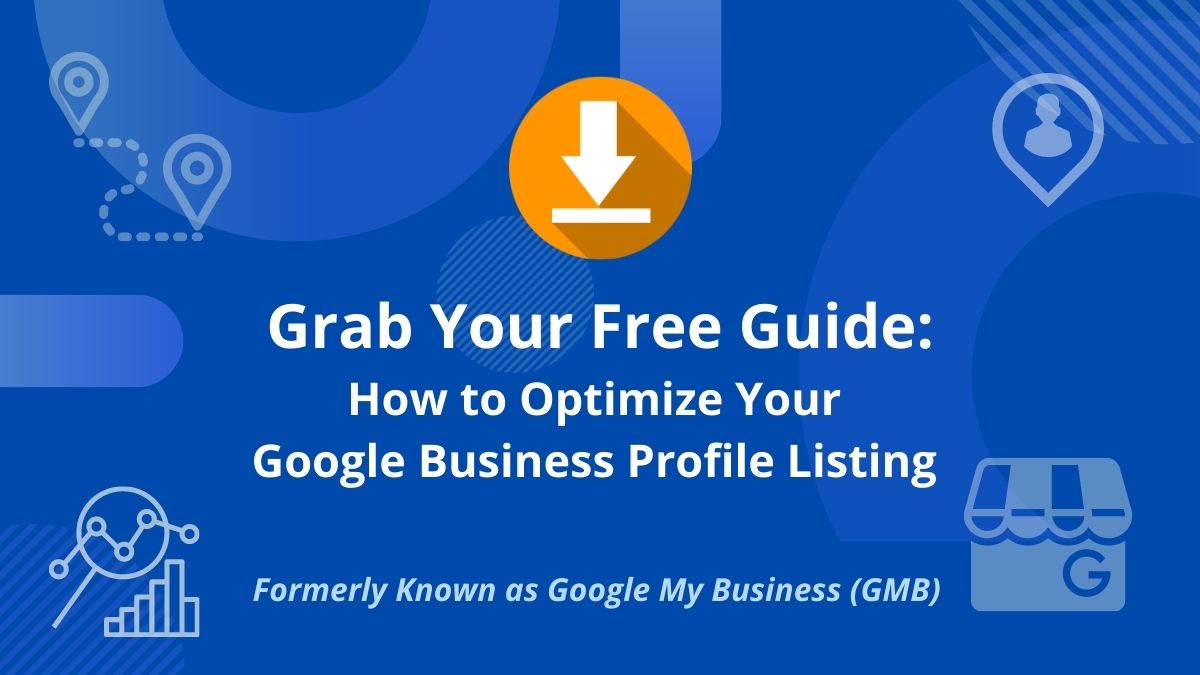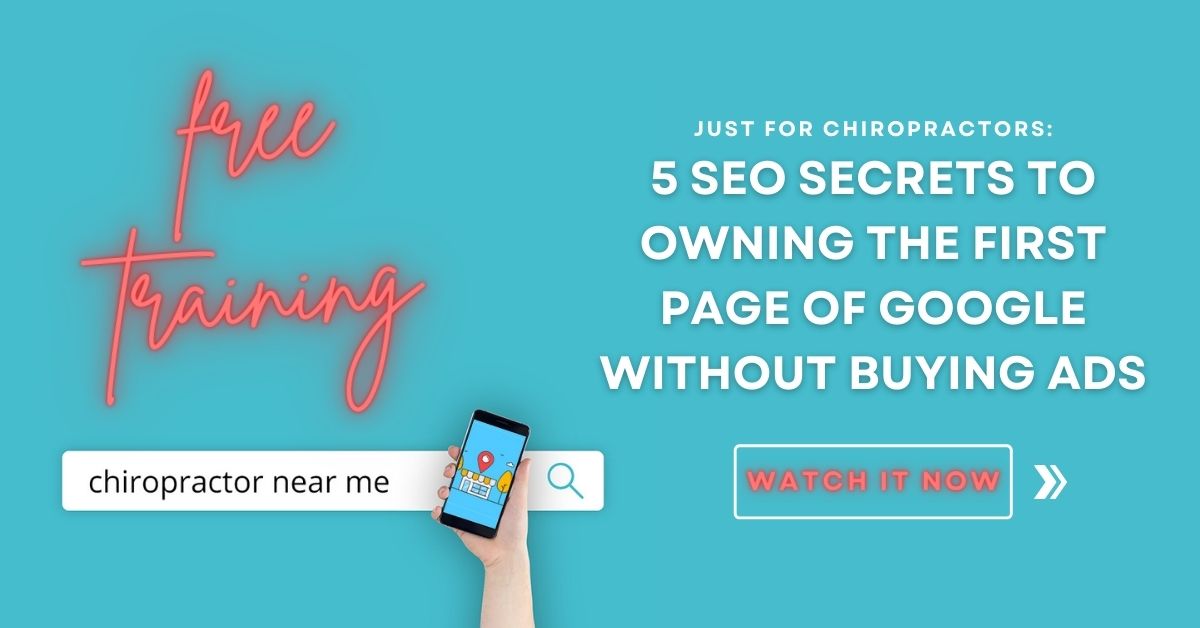Search engine optimization (SEO) is the driving force behind your chiropractic clinic’s online success. SEO for chiropractors must be done with thoughtful intent to get the right website visitors. With the right website traffic comes new patients to your clinic.
As a chiropractor, you may be uninterested in perfecting an SEO strategy, but we’re here to tell you: You can’t afford to make that misguided decision. SEO is here indefinitely, it’s constantly evolving to meet the users’ needs, and when done correctly, it will strengthen your business considerably.
In this ultimate SEO guide for chiropractors, we’re giving you our best SEO tips so you can reach the right audience at the right time, climb the Google ladder, get new patients while engaging with old patients, and find the success you’re looking for.
If that sounds good to you, let’s get into it.
Chiropractor Off-Page SEO: Verify Your Google Business Profile
This is super simple and 100% VITAL: Your Google Business Profile (GBP) is one of the primary ways you’ll get in front of searchers. This listing pops up before any of the organic search results, so you’re right there on top for all to see (and click on).
Your GBP will give searchers all the valuable information they’re looking for right off the bat (without needing to head to your site); some information includes:
- Location
- Map and directions
- Phone number
- Images
- Reviews
- Hours
- Services
- Social channels
- Links to your website, blog, booking calendar, resources, etc.
This data makes it easy for people to learn about you, get to you, make an appointment with you, contact you, and all the good stuff. Use keywords when setting this up and optimize your images so you can maximize your SEO efforts.
If you haven’t set this up yet, now is the time. It should be done immediately, so make this your priority. (While you’re at it, be sure to set up your Bing Places for Business and Yahoo Business Listing accounts, too!)
Chiropractor On-Page SEO: Create a Responsive, User-Friendly Website on Computer & Mobile
User experience (UX) is a leader in the SEO game. If your users are unhappy with your website, they’ll leave it. Even if you have the most outstanding services, content made of dreams and dollar bills, and images that are so stunning, they defy reason.
If those stunning images take more than THREE SECONDS to load, kiss your would-be visitor goodbye because they just went to your competitor with lack-luster images that load really fast.
Here are some elements for a great UX:
- Fast page speed (loading)
- Mobile-friendly and optimized
- Extraordinary, unique, relevant, engaging content
- Excellent page design and color (branding)
- Smart and sensical navigation
- Easy-to-read and understand content
- Fast identification of services and specialties
- Clear calls to action (CTAs)
- Staff bios are always a crowd-pleaser (you can be less formal with these, show some personality)
- Have FAQs, resources, tips, etc.
- Images and videos (of you, your staff, your patients, and your space- not stock photos!)
- Highlighted reviews or testimonials
- Links to social channels
Your website needs to provide your visitor with everything they could possibly ask for, so this is a living, breathing piece of the puzzle (meaning you will need to make updates and edits accordingly).
>> Learn more about designing pages for a successful website.
Pro tip: Consider adding:
- A chatbox to your site for quick responses to general questions
- Telehealth support for those patients who can’t make it to your clinic
- Patient portal access so patients can see their activity, review results, make appointments, ask questions, reorder supplements, etc.
Build a Meticulous Local SEO Strategy for Your Chiropractic Clinic
Chiropractors tend to have a physical location, meaning they need locals coming through their doors; your local SEO campaign is designed to help make this happen.
Nearly half of Google’s daily searches are for local businesses per a Go Gulf study, and “near me” searches are climbing astronomically every year, so optimizing for local isn’t a trend; it’s a duty.
Local SEO tips:
- If you have multiple locations, be sure to create a page dedicated to each and drop in some local flair and verbiage
- Use local keywords in your content
- Optimize every image on each page and be sure to use local images specific to that location whenever possible
- Put a Google Map on each location page and your Contact Us Page
- Ensure your NAP (name, address, phone) is correct everywhere and for each listing, be sure to stay consistent with these; for example, if you have 123 Main Street on your GBP listing, it should NOT say 123 Main St. on your Contact Us Page
Do Keyword Research for Your Chiropractic Clinic
Before you write your content, you need to know what your visitors are searching for, so you can ensure those keywords and keyword phrases make it into your copy. Your keywords tell Google when to offer your page as a result of a query.
These keywords should be found:
- Throughout your website pages
- In your blog posts
- In your page, section, and blog post headers
- When optimizing your images and videos
- In your title tags and meta descriptions
Keyword research has become easier over the years with dozens of great tools to help your efforts (many are free).
Some keyword research tools include:
Pro tip: Don’t just focus on the words “chiropractor + name-of-city” or “chiropractic + name-of-city” (i.e.: Denver chiropractic clinic). Be sure you’re using all the main keywords and keyword phrases your audience is using so they can find you (i.e.: back pain, prenatal chiropractic care, poor posture, how do I stretch at work, etc.)
Create Excellent Content for Your Chiropractic Practice
Once you’ve determined what your target audience is searching for (the keywords being used), you can start creating the content that will impact that audience. They say content is king, and it’s very overused, but that’s because it’s still true.
Your content needs to be:
- Unique
- Creative
- Valuable
- Informative
- Relevant
- Educational
- Trustworthy
And besides all those things, it needs to be good! Find your voice and tone, then get to designing the content your users are yearning for.
This can be done in many forms (content is NOT just copy):
- Webpage copy
- Blog posts
- Videos
- Images
- Infographics
- Social media
- Newsletters
- Emails
- White papers
- YouTube channel
- Podcasts
- Courses
- Webinars
The more content you have out there, the better (if it’s good). You can become a true authority in the field, so don’t underestimate the importance of your beneficial, reliable content. Be an expert, and you’ll get the website traffic that matters.
We know this can get overwhelming, and we hear you; you’re not alone in feeling that way. Don’t try to create and perfect all this content overnight; that’s impossible; you have a clinic to run. Just start with one piece of content and go from there.
Pro tip: NEVER forget to add your CTA after a content piece. What action are you hoping your visitor takes next? Sign up for your email? Subscribe to your channel or blog post? Share your article? Book an appointment? Whatever it is, have a button ready and waiting for them to make the next move.
Blog Like Nobody’s Business
We’re sorry, we really are, but you gotta be blogging and blogging well. Yes, it takes time, but guess what? Practice makes perfect. You know that. Guess what else? You don’t need to make it overly complicated. If short and sweet is your thing, make it count, and Google will still reward you.
Keeping posts around 1500 words is best, but if you simply can’t do it, be sure to use the right keywords, drop in some images or videos (or both), make it engaging and purposeful, and you could definitely have yourself a winner without the word count.
The goal is to get a following. Get the visitors to come to your blog often. And, better yet, share the posts. If you’re doing that, Google will notice, and it won’t be mad at you.
Pro tip: Create a content calendar so you have a defined timeframe to work on your blog posts and other content pieces. If you have a team, you’ll know who’s in charge of what, where a piece is in the process, deadlines, and more. If you work solo, you have no excuse not to work on content because time and scheduling have been pre-approved by your boss (who is you).
Stay On Top of Your Reviews
Your reviews are an incredibly powerful marketing tool. And they’re free to you. That doesn’t mean they don’t require a bit of work and upkeep. You should always make it easy for your patients to leave you a review on Google (your GBP listing will show them), Facebook, and Yelp.
Your main, number one priority when it comes to reviews (after getting them, of course) is to answer them. DO NOT FORGET. Especially the bad ones. Everyone loves a redemption story. If you messed up (and you will because you’re human), apologize, make it right. Remember: You can’t make everyone happy; you can only do your best.
We also suggest showcasing relevant reviews throughout the pages of your website. For example, on your Back Pain Page, have a handful of reviews specifically from back pain patients on that page. If you want a page dedicated solely to your testimonials, that’s great, too. Do both.
Video works great with testimonials, so ask some patients if you can film them giving their feedback (you can do this with your phone, no need to get too fancy). This is a great way to tell potential new patients how terrific you are and show off some personality and behind-the-scenes interactions.
Pro tip: Make a little comedic out-take reel of the bloopers, let them see the people behind the brand. Who couldn’t use a little unexpected laugh?
Create a Winning Social Media Campaign
Social media is fast becoming the go-to for finding services, especially with the under 40 crowd. Figure out where your audience is, and you be there, too. Facebook? Instagram? LinkedIn? TikTok? Twitter? These channels will help support your business, provided you deliver successful content.
Tips for a successful social media campaign:
- Promote new content as you make it (blog posts, videos, courses, vlogs, etc.)
- In no-new-content times, promote already created content that’s still relevant (evergreen content)
- Promote events, relevant news, updates to your website or services, etc.
- Promote your resources
- Link to other wellness sources
- Link to your partners (such as a local gym, nutritionist, high school, etc.)
- Give health tips
- Show educational exercise videos
- Provide recipes for smoothies, healthy cocktails, your secret BBQ sauce, smoked parmesan asparagus, etc.
- Share personal images of you or your staff training for an event or volunteering at a charity
- Take polls, create games, drawings, challenges, etc.
Social media is another platform where you can show some personality and get your audience to engage with you, so have some fun with it.
Optimize for Voice Search
Voice search optimization has been steadily increasing, and if you ask us, that’s just gonna keep happening. With Alexa, Siri, and Hey Google becoming the quasi, uber-smart family members we never knew we wanted comes another layer of SEO practices.
Don’t worry; they’re not exasperating. Optimize for voice search by creating content around a more natural speaking model. For example, while typing in a Google query on your computer, you may write: back pain after driving. But while asking your Google smart speaker, you may say: “Hey Google, why does my back hurt after driving?” See the difference?
So, what’s a great way to ensure you take advantage of the smart speaker SEO game?
- Create a FAQ page where you ask the questions your visitors are asking
- Include “near me” in your copy
- Use conversational keywords throughout your copy
- Use long-tail keywords (longer, more specific keyword phrases) throughout your copy
- Be mobile-friendly
- Optimize your Google Business Profile
Analyze the Data of Your Chiropractic Website & Its Content
This cannot be overstated, and it is so often neglected- if you don’t know how your website, content, and social campaigns are performing, how do you know they’re working? You MUST analyze your data. Yes, that sounds really technical. But, honestly, it’s not so bad.
Google Analytics is a free tool that gives you loads of intel on how your pages and social media are performing. Armed with this information, you can make educated decisions that best support your user’s needs. This will help improve your ROI, nurture stronger relationships with your visitors, and enhance your marketing efforts.
Learn stats like:
- Who’s visiting your site and how they got to it
- How long they’re on your site
- What pages they’re going to
- If they’re bouncing (leaving without taking the action you wanted them to)
- And more
If you want to maximize your ROI, these reports will give you the data to help do it.
Get New Patients, Keep the Current, Connect With the Old Through a Smart Local SEO Strategy
Patients are your bread and butter; keeping them happy is essential to your success, and SEO is the glue that holds those two things together. Well, bedside manner goes a long way, too.
When you have a successful chiropractic SEO strategy, you’re giving your visitors and patients what they want: a great UX, informative content, easily found company details, accountability, personality, and so much more. SEO is a long-game game-changer, and it’s continuously developing, but it’s here for you, and it wants you to be successful.
If content marketing seems out of reach for you, Propel Marketing & Design is happy to help. We can offer minor advice or significant hand-holding, whatever you need. Book a discovery call and let’s get your SEO efforts noticed- you, your clinic, and your patients deserve it.






![How to Write a Professional Chiropractic Bio [Template Included]](https://propelyourcompany.com/wp-content/uploads/write-a-bio-500x383.jpg)

